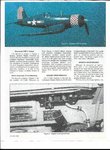Hello everyone! First time posting here, but long time lurker. Lots of great info on this forum; I have learned so much about a subject I thought I knew pretty well!
In June 1990, the EAA's magazine Sport Aviation published an article called "Flight Test Comparison...Ending the Argument" by John Ellis and Christopher Wheal. The article was a modern-day performance comparison between a P-47D Thunderbolt, P-51D Mustang, FG-1D Corsair, and F6F-5 Hellcat. This was not an analysis of WWII-era data but rather an actual flight test of the four aircraft which compared their performance and flight characteristics.
It's an interesting article and thought everyone here would enjoy reading/discussing it. I recently obtained a copy of it through EAA's archive and can provide scans of the article if requested. I did a search for this article on this forum but did not find anything; if it has been discussed before then I apologize and ask if someone could provide a link to the appropriate thread.
You can find an online copy of the article at www.coursehero.com but you have to sign up to be a member (don't know if it costs anything or not). I'd be happy to post scans of the article here, but I'm not sure how to do it and don't want to get into any trouble with copywriting or anything like that. Some help would be appreciated!
In June 1990, the EAA's magazine Sport Aviation published an article called "Flight Test Comparison...Ending the Argument" by John Ellis and Christopher Wheal. The article was a modern-day performance comparison between a P-47D Thunderbolt, P-51D Mustang, FG-1D Corsair, and F6F-5 Hellcat. This was not an analysis of WWII-era data but rather an actual flight test of the four aircraft which compared their performance and flight characteristics.
It's an interesting article and thought everyone here would enjoy reading/discussing it. I recently obtained a copy of it through EAA's archive and can provide scans of the article if requested. I did a search for this article on this forum but did not find anything; if it has been discussed before then I apologize and ask if someone could provide a link to the appropriate thread.
You can find an online copy of the article at www.coursehero.com but you have to sign up to be a member (don't know if it costs anything or not). I'd be happy to post scans of the article here, but I'm not sure how to do it and don't want to get into any trouble with copywriting or anything like that. Some help would be appreciated!










